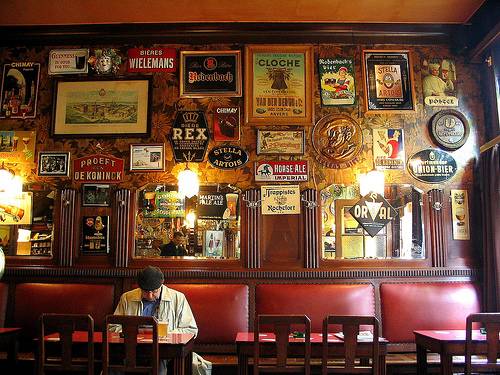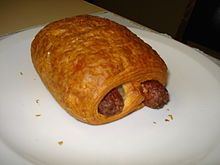My favourite bar: ‘Oud Arsenaal’
 One of the really authentic bars in town is called ‘Oud Arsenaal’ (Old Arsenal) and is situated in the Maria Pijpelinckxstraat. In case you didn’t know: Maria Pijpelinckx was Rubens’ mother, so it shouldn’t surprise you you can find this bar in the neighbourhood of the Rubens House Museum.
One of the really authentic bars in town is called ‘Oud Arsenaal’ (Old Arsenal) and is situated in the Maria Pijpelinckxstraat. In case you didn’t know: Maria Pijpelinckx was Rubens’ mother, so it shouldn’t surprise you you can find this bar in the neighbourhood of the Rubens House Museum.
It has been a bar ever since 1924 and the building itself dates back to early 19th century. The starting date of the bar can still be read in the inscription above the door. The shop front has these orange-brown coloured ceramic tiles and probably the interior dates back to 1932. In that year a permit was granted to enlarge the café and at that moment the art-deco interior was installed, with its brown and yellow floor tiles, and its walls covered with wooden benches, mirrors and wooden wainscoting.
 When you enter the cafe, you make a trip through time, going back nearly a hundred years. In 2009 a search was held to look for really authentic public bars and ‘Oud Arsenaal’ was selected as one of the top-locations.
When you enter the cafe, you make a trip through time, going back nearly a hundred years. In 2009 a search was held to look for really authentic public bars and ‘Oud Arsenaal’ was selected as one of the top-locations.
And another reason to go there: Steph, the landlord, has a really impressive choice of fine beers from all over the country and that at very affordable prices.
Oud Arsenaal
Maria Pijpelinckxstraat 14
Wed-Fri: 10:00-22:00
Sat-Sun: 07:30 – 19:30
Saturdays and Sundays a market (Vogeltjesmarkt) is being held in the immediate neighbourhood, that explains the early opening hours.
 Although a number of historical churches have vanished (e.g. the Walburgischurch in the very center of the old town, and the church belonging to the St-Michael’s cloister in the environment of the Kloosterstraat), we still have 5 churches with a rich historical background.
Although a number of historical churches have vanished (e.g. the Walburgischurch in the very center of the old town, and the church belonging to the St-Michael’s cloister in the environment of the Kloosterstraat), we still have 5 churches with a rich historical background. The youngest of the historical churches is the Jesuits’ church: St-Carl-Borromeus. Its façade is a fine example of baroque art, but only inside will you be able to feel the effect of baroque completely, especially when you enter the Houtappel chapel (to your right facing the main altar). Also this church is closely connected with Rubens as there are clear signs that Rubens had a hand in the design of both the façade and the tower. Originally the aisles left and right had their ceilings painted by Rubens, but a fire in 1718 destroyed all of these paintings. Rubens also painted two large canvases for the main altar, but the originals are now on display in Vienna. The really unique thing about this church is that the painting adorning the main altar can be switched. The original device to perform this feat is still active and is being used four times a year.
The youngest of the historical churches is the Jesuits’ church: St-Carl-Borromeus. Its façade is a fine example of baroque art, but only inside will you be able to feel the effect of baroque completely, especially when you enter the Houtappel chapel (to your right facing the main altar). Also this church is closely connected with Rubens as there are clear signs that Rubens had a hand in the design of both the façade and the tower. Originally the aisles left and right had their ceilings painted by Rubens, but a fire in 1718 destroyed all of these paintings. Rubens also painted two large canvases for the main altar, but the originals are now on display in Vienna. The really unique thing about this church is that the painting adorning the main altar can be switched. The original device to perform this feat is still active and is being used four times a year. Another church linked with Rubens is St-James’s, located near St-Jacobsmarkt, entrance via the southern aisle in Lange Nieuwstraat. Here the master is buried beneath a painting of his own choice. This church boasts a very impressive main altar in baroque style and an organ on which the young Mozart one gave a concert as he passed Antwerp in the company of his father and his sister.
Another church linked with Rubens is St-James’s, located near St-Jacobsmarkt, entrance via the southern aisle in Lange Nieuwstraat. Here the master is buried beneath a painting of his own choice. This church boasts a very impressive main altar in baroque style and an organ on which the young Mozart one gave a concert as he passed Antwerp in the company of his father and his sister. Last but not least there’s St-Andrew’s (entrance Waaistraat) which boasts what is probably the most fascinating pulpit in the world.
Last but not least there’s St-Andrew’s (entrance Waaistraat) which boasts what is probably the most fascinating pulpit in the world. Jan 28th the Chinese New Year was celebrated in Chinatown in the Central Station area of the city. Especially Wednesday Feb 1st will be a noisy day as fireworks and crackers are going to drive away the evil demons. But as from this year this is not the end of celebrations: the following weekend ‘The Asian Lifestyle Group’ is staging a food festival under the name ‘Asia in Antwerp’.
Jan 28th the Chinese New Year was celebrated in Chinatown in the Central Station area of the city. Especially Wednesday Feb 1st will be a noisy day as fireworks and crackers are going to drive away the evil demons. But as from this year this is not the end of celebrations: the following weekend ‘The Asian Lifestyle Group’ is staging a food festival under the name ‘Asia in Antwerp’.


 The Time Machine Project, a cooperation of 70 organizations from 20 European countries is trying to get the necessary funds from the European authorities to complete the project. One of the organizations is the Antwerp University.
The Time Machine Project, a cooperation of 70 organizations from 20 European countries is trying to get the necessary funds from the European authorities to complete the project. One of the organizations is the Antwerp University.